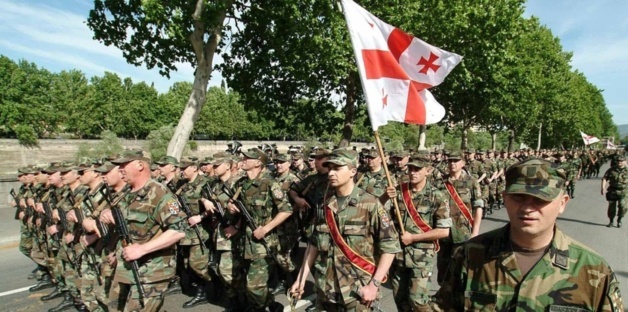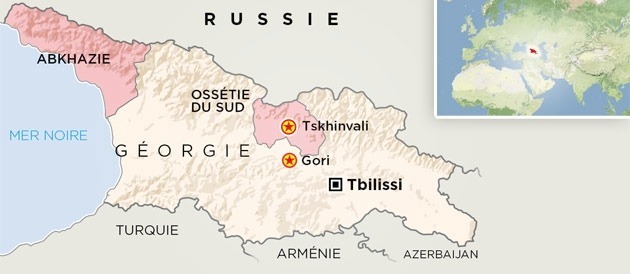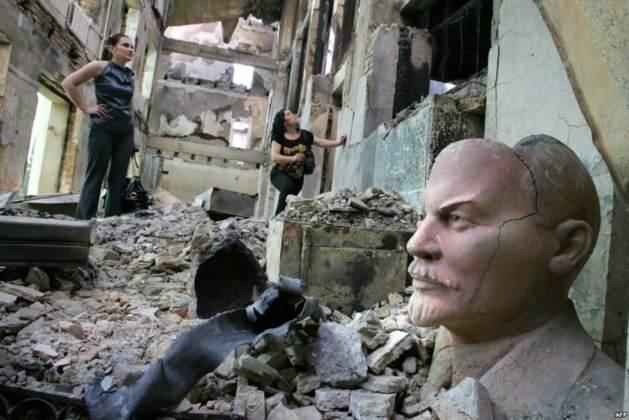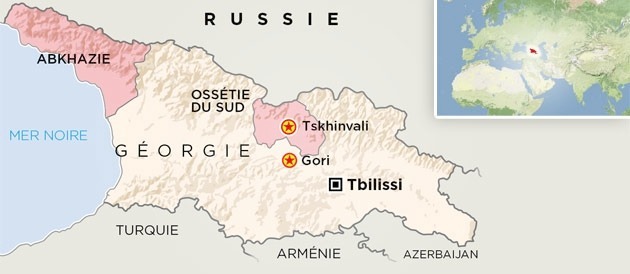
Credits -- InterPressNews
This comes from the current geopolitical context of common opposition between Russia and its “close foreigner”, its neighbor which would prefer to be far away from there. These tensions have been focused on the small autonomous Georgian republic of South Ossetia.
At the beginning, Stalin created this engineered province in order to divide and rule rebel Georgia, that declared itself an independent republic in 1990. Now, it is the area where the two countries are fighting. With a population of about 100,000 inhabitants who are two-third Ossetians, South Ossetia is today recognized by half-a-dozen countries; among them is the Russian Federation. Though, like Abkhazia and Transnistria, South Ossetia is one of the figurehead States that only exists by the will and portfolio of the Kremlin with little or no ambition of independence.
In August 2008, the Russian army led a quick counter offensive against a blitzkrieg style attack in South Ossetia by the national Georgian troops, in order to keep its ally’s territorial integrity. After a five-day siege, the two factions signed a ceasefire agreement to declare the status quo. To this day, it is still in effect. What can explain this dedication of no concessions from both Russia and Georgia for a conflict that seems to be negligible?
At the beginning, Stalin created this engineered province in order to divide and rule rebel Georgia, that declared itself an independent republic in 1990. Now, it is the area where the two countries are fighting. With a population of about 100,000 inhabitants who are two-third Ossetians, South Ossetia is today recognized by half-a-dozen countries; among them is the Russian Federation. Though, like Abkhazia and Transnistria, South Ossetia is one of the figurehead States that only exists by the will and portfolio of the Kremlin with little or no ambition of independence.
In August 2008, the Russian army led a quick counter offensive against a blitzkrieg style attack in South Ossetia by the national Georgian troops, in order to keep its ally’s territorial integrity. After a five-day siege, the two factions signed a ceasefire agreement to declare the status quo. To this day, it is still in effect. What can explain this dedication of no concessions from both Russia and Georgia for a conflict that seems to be negligible?
Geopolitical interests coming from the foreign irredentism

Russian defense of Ossetians is a self-serving alibi, not a humanitarian and altruist act. By doing so, they prevent Georgia from keeping its sovereignty on the whole territory -though united by its history- and so they prevent this strongly hostile Caucasus republic to thrive. After the Five-Day War, in August 2008, Georgia eventually stopped the discussions to be integrated into NATO.
Russians also use this very well led military operation to set again their status as an international power, and so change the habit of successive diplomatic back-pedals that occurred since the USSR crackdown. Furthermore, they have great energy interests in this area: they cannot turn their back on this strategic crossroad made of gas and oil fields in the Caspian and Black seas region, moreover a gateway to Europe.
Russians also use this very well led military operation to set again their status as an international power, and so change the habit of successive diplomatic back-pedals that occurred since the USSR crackdown. Furthermore, they have great energy interests in this area: they cannot turn their back on this strategic crossroad made of gas and oil fields in the Caspian and Black seas region, moreover a gateway to Europe.
“Everyone of us hope that Russia will remain our ally until the end”

South Ossetia is dependent upon Russia. Yet Russia is keeping the province greatly isolated as the Georgian-Ossetian border is guarded by a numerous Russian-soldier garrison. That is violating all the treaties already signed. Yet there is no more family bound between Ossetians and Georgians since a two-decade mutual hate. Both communities – Georgian and Ossetian – don’t share the same roads or the same electricity provider nets.
Even if, according to the South-Ossetian Foreign Minister, “the Russian Federation acknowledgement of the South Ossetia independence created the feeling to be in security”, Ossetia lost its internal freedom to win this external protection.
The Kremlin’s noticeable interference in the domestic affairs of the territory caused a never-before-seen political crisis in November of 2011. The Supreme Court invalidated the result of the vote and forbid the winner Alla Dzhioeva to run again for president, as the “Kremlin” candidate lost the run-off by 44 % of the votes. They finally found a last-minute agreement. The external protection of South Ossetia is much stronger than its internal situation.
Economically, the ruble is dominating. Russia shared its money and its Customs Unions with the secessionist province. The administration is able to supply its population in the huge needs they have after the 2008 destructions thanks to the financial help from Russia. It represents about € 1,700 (US$ 2,300) per year per person; it is ten times the average month salary. They have a saying in Tskhinvali to show irony about Russia keeping South Ossetia alive but enable to move alone: “Russia helps those that help themselves”.
According to a clause inherited from the Soviet Union crackdown, 70 % of the Ossetian population has a Russian passport. The federal Russian legislation makes a difference between citizenship and nationality, inherited from the USSR; nationals from ex-soviet countries can get the Russian nationality if they refuse to get the one from their new country. This way, the individual mobility is made widely easier towards the other territory of the Ossetian minority, Russia’s autonomous region of Northern Ossetia.
Here is where the Russian strategy is flawed: the first claim of the Ossetian minority is to unify the two territories to make an independent Republic. Of course, Moscow can’t accept this. So, Ossetian minority is an excuse to the country that has often proved it was not attached to the “right of peoples to self-determination”.
This is how Stalin, Little Father of the Peoples with an Ossetian father and still considered with strange kindness by most of Russians and Caucasians, was used as a Trojan horse in an imperialist policy that Moscow completely takes on, 60 years after he died.
Even if, according to the South-Ossetian Foreign Minister, “the Russian Federation acknowledgement of the South Ossetia independence created the feeling to be in security”, Ossetia lost its internal freedom to win this external protection.
The Kremlin’s noticeable interference in the domestic affairs of the territory caused a never-before-seen political crisis in November of 2011. The Supreme Court invalidated the result of the vote and forbid the winner Alla Dzhioeva to run again for president, as the “Kremlin” candidate lost the run-off by 44 % of the votes. They finally found a last-minute agreement. The external protection of South Ossetia is much stronger than its internal situation.
Economically, the ruble is dominating. Russia shared its money and its Customs Unions with the secessionist province. The administration is able to supply its population in the huge needs they have after the 2008 destructions thanks to the financial help from Russia. It represents about € 1,700 (US$ 2,300) per year per person; it is ten times the average month salary. They have a saying in Tskhinvali to show irony about Russia keeping South Ossetia alive but enable to move alone: “Russia helps those that help themselves”.
According to a clause inherited from the Soviet Union crackdown, 70 % of the Ossetian population has a Russian passport. The federal Russian legislation makes a difference between citizenship and nationality, inherited from the USSR; nationals from ex-soviet countries can get the Russian nationality if they refuse to get the one from their new country. This way, the individual mobility is made widely easier towards the other territory of the Ossetian minority, Russia’s autonomous region of Northern Ossetia.
Here is where the Russian strategy is flawed: the first claim of the Ossetian minority is to unify the two territories to make an independent Republic. Of course, Moscow can’t accept this. So, Ossetian minority is an excuse to the country that has often proved it was not attached to the “right of peoples to self-determination”.
This is how Stalin, Little Father of the Peoples with an Ossetian father and still considered with strange kindness by most of Russians and Caucasians, was used as a Trojan horse in an imperialist policy that Moscow completely takes on, 60 years after he died.




























